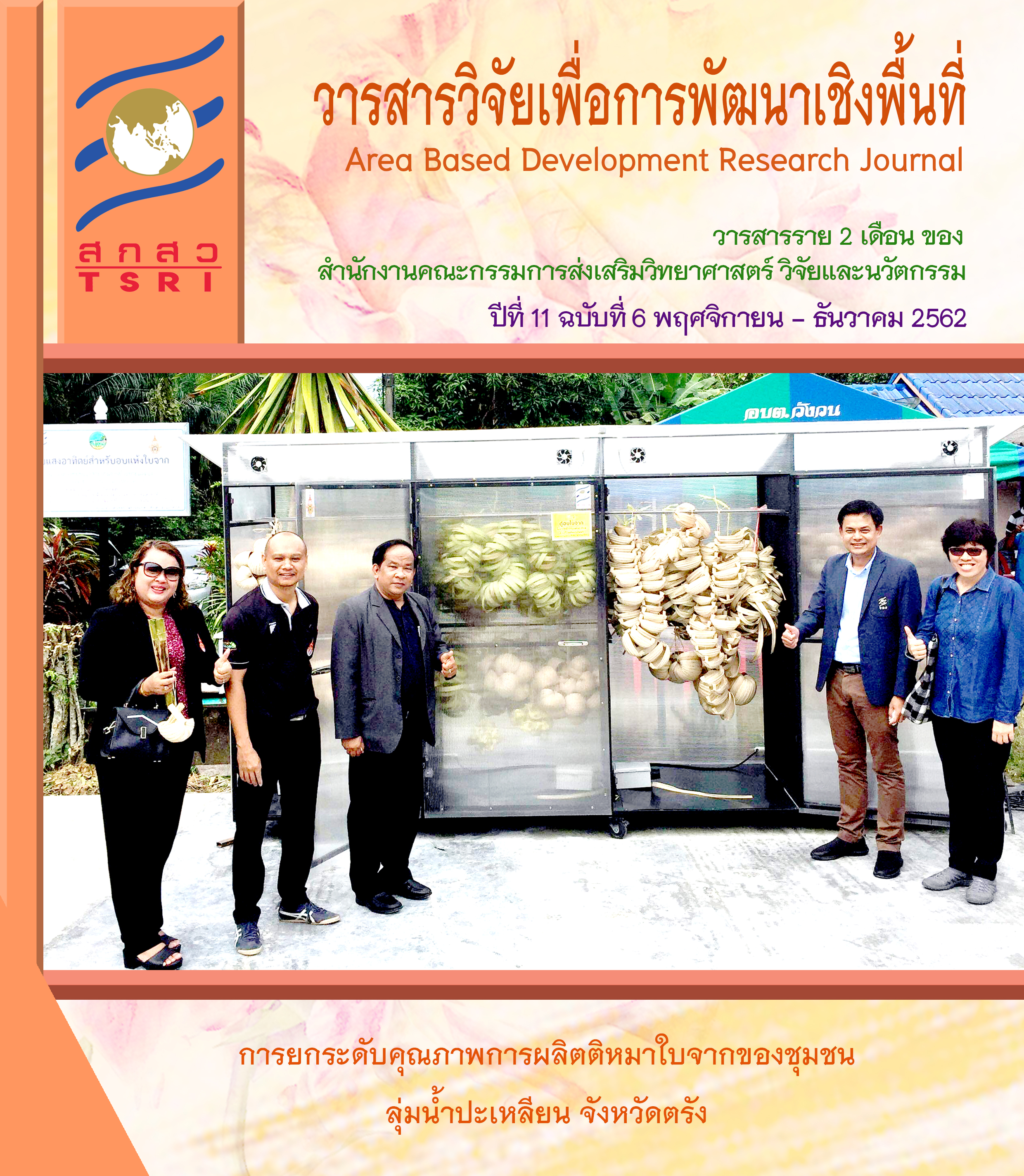Production Quality Development of Nipa Palm Bowl of Palian River Basin Community, Trang Province
Main Article Content
Abstract
The objective of this research is to upgrade the quality of Nipa palm bowl production of Palian river basin by using solar dryer technology. The study is performed with the participation of community in every step e.g. preparation of materials for testing, solar dryer testing and defect studies to improve technology efficiency. The Nipa palm bowl production capacity has been found to increase while the production time reduced from 1day to only 3 hours. The technology was employed by the community enterprise group, “Ban Na Yod Tong basketry”. The efficiency in Nipa palm bowl production increases from 1,300 to 17,000 pieces per month, or 12 times higher. The income of approximately 157,000 Baht per month has been generated to the group, making a total of 1,570,000 Baht in the period of 10 months. The researcher and the leader of the community have collaboratively established a network for Nipa palm bowl production in Palian river basin in which community members from different areas collectively produce Nipa palm bowls and sell to the group. Recently, the group has expanded and it comprises 20 members, from only 5 during the formation stage. The follow-up 8 months after completing the research project reveals that the community has formally adopted the technology. The group’s Nipa palm bowls sales count for 27,600 pieces per month, that is an increase of 26,300 pieces per month, which is 20 times higher than the prior production process. By using the technology, the group can generate an income of 2,104,000 Baht. At present, the group has 80 members. The total income of the Palian river basin community from using this technology calculated from July 2017-December 2018 is 3.77 million Baht. This can help the community reduce the waste from Nipa palm of 12 tons per year.
Article Details

This work is licensed under a Creative Commons Attribution-NonCommercial-NoDerivatives 4.0 International License.
Area Based Development Research Journal values copyright protection and licensing to safeguard author rights and facilitate the appropriate dissemination of research. Our policies ensure openness, accessibility, and attribution. Authors retain copyright ownership, and articles are published under a Creative Commons Attribution License (CC BY), allowing sharing, adaptation, and proper attribution. Authors have the freedom to publish under the CC BY license, granting broad reuse and distribution permissions. The journal supports posting articles on third-party repositories, adhering to institutional and funding restrictions. Author guidelines detail copyright and licensing requirements, empowering authors with knowledge about their rights and responsibilities. These policies cultivate an environment of collaboration, openness, and responsible sharing, benefiting authors and the research community while honoring intellectual property rights.
References
อาหารและภาชนะสัมผัสอาหารฉบับที่ 3 (พ.ศ. 2560). นนทบุรี: กระทรวงสาธารณสุข, 26 น.
จาตุรงค์ คงแก้ว, เยาวนิจ กิตติธรกุล, และ ก้องเกียรติ กิตติวัฒนาวงศ์. (2560). กระบวนการพัฒนาพื้นที่การจัดการทรัพยากรทางทะเลและชายฝั่งโดยการมีส่วนร่วมของชุมชน: กรณีศึกษา เขตอนุรักษ์หอยปะ ลุ่มน้ำปะเหลียน จังหวัดตรัง. วารสารหาดใหญ่วิชาการ, 15(2), 147-163.
ชาลีดา บรมพิชัยชาติกุล. (2555). เทคโนโลยีการทำแห้งแบบผสมผสาน : การนำมาใช้เพื่อถนอมผลิตภัณฑ์อาหารที่ไวต่อความร้อน. วารสารวิจัยและพัฒนา มจธ., 35(2), 269-282.
ธีรเดช ใหญ่บก, สุวิทย์ เพชรห้วยลึก, จอมภพ แววศักดิ์, มารีนา มะหนิ, และ ภรพนา บัวเพชร. (2553). การพัฒนากระบวนการอบแห้งปลาด้วยเครื่องอบแห้งพลังงานร่วมแสงอาทิตย์-ไฟฟ้า ภายใต้สภาพภูมิอากาศภาคใต้ของประเทศไทย. วารสารมหาวิทยาลัยทักษิณ, 12(3), 109-118.
นพดล โพชกำเหนิด และ สมบูรณ์ ประสงค์จันทร์. (2556). การผลิตไวน์จากลูกจากโดยใช้การหมักด้วยยีสต์ทางการค้า. วารสารการพัฒนาชุมชนและคุณภาพชีวิต, 1(2), 81-88.
นพดล โพชกำเหนิด. (2559). หมู่บ้านแปรรูปปลาท่องเที่ยว ประจำปีงบประมาณ 2559 คลินิกเทคโนโลยีมหาวิทยาลัยเทคโนโลยีราชมงคลศรีวิชัย. สืบค้นเมื่อ 30 กันยายน 2562, จาก http://www.clinictech.most.go.th/online/UserManage/FinalReport/20177201534431.pdf
นัฑพงศ์ สิงห์ศร, รักชาติ ท่าโพธิ์, และ คัชรินทร์ เวชชากุล. (2557). ตู้อบแสงอาทิตย์ที่ทำจากแผ่นโพลีคาร์บอเนต. การเกษตรราชภัฏ, 13(1), 47-52.
สมบูรณ์ ประสงค์จันทร์, นพดล โพชกำเหนิด, กิตติ พิมเสน, เสริมศักดิ์ สัญญาโณ, ทิพย์ทิวา สัมพันธมิตร, และ จำนง ฐานะพันธ์. (2556). การใช้ประโยชน์ป่าจากบริเวณทะเลสาบสงขลา ในเขตตำบลชะแล้ และตำบลปากรอ อำเภอสิงนคร จังหวัดสงขลา. วารสารการพัฒนาชุมชนและคุณภาพชีวิต, 1(1), 67-76.
สำนักงานปลัดกระทรวงพลังงาน สำนักนโยบายและยุทธศาสตร์. (2550). คู่มืออบรมพลังงาน รวมเทคโนโลยีพลังงานชุมชน. กรุงเทพฯ: กระทรวงพลังงาน.
สุวัจน์ ธัญรส, อภิรักษ์ สงรักษ์, ประภาศรี ศรีชัย, และ วรพร ธารางกูร. (2560). การจัดการทรัพยากรแบบมีส่วนร่วมเพื่อพัฒนาคุณภาพชีวิตของชุมชนลุ่มน้ำปะเหลียน จังหวัดตรัง. สืบค้นเมื่อ 22 สิงหาคม 2562, จาก https://elibrary.trf.or.th/search_ab4.asp.
Badve, R. M., & Sakurkar, C.V. (2003). On the disappearance of palm genus Nypa from the west coast with its present status in the Indian subcontinent. Current Science Journal, 85, 1407–1409.
Bahloul, N., Boudhrioua, N., Kouhila, M., & Kechaou, N. (2009). Effect of convective solar drying on colour, total phenols and scavenging activity of olive leaves (Olea europaea L). International Journal of Food Science and Technology, 44(12), 2561-2567
Etawil, M.A., Azam, M.M., & Alghannam, A.O. (2018). Energy analysis of hybrid solar tunnel dryer with PV system and solar collector for drying mint (MenthaViridis). Journal of Cleaner Production, 181, 352-364.
Podkumnerd, N., Wunsri, S., & Khairin, S. (2019). Production process development of nipa bowl from nipa palm (Nypa fruticans Wurmb.) waste by using solar dryer cabinet for sustainability of Palian river basin community. Malaysian Journal of Fundamental and Applied Sciences, 15(4), 593-596.
Teo, S., Ang, W.F., Lok, A.F.S.L., Kurukulasuriya, B.R., & Tan, H.T.W. (2010). The status and distribution of the nipah, Nypa fruticans Wurmb (Arecaceae), in Singapore. Nature in Singapore, 3, 45–52.
Yahya, M., Othman, M. Y., Sopian, K., Daud, W. R. W., & Yatim, B. (2004). Quality of Pegaga leaf dried in a solar assisted dehumidification drying system. Proceeding of the 14th International Drying Symposium (IDS 2004). Sao Paulo, Brazil. vol. B, pp. 1049-1054.


